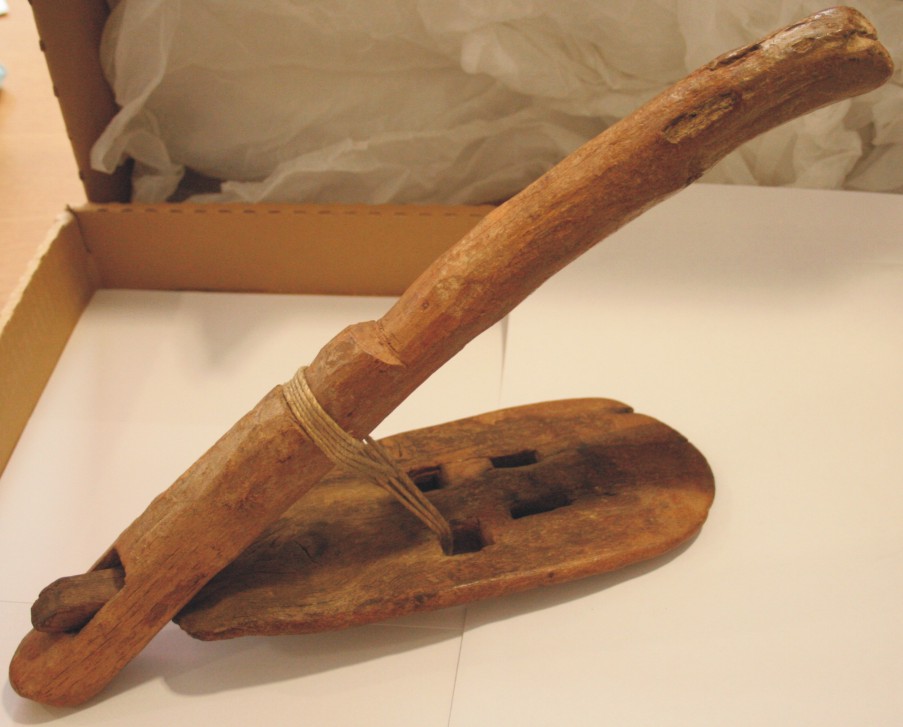EC601
EC601 A hoe or ard.

Model hand plough, hoe or ard with modern stringing. 32cm long. See Brovarski, et al. (1982 p 46) and Petrie (1917, 54, pl. LXVIII, 62) for similar examples. Such items were used for breaking up the soil in preparation for sowing, the ritual of the breaking of the soil, but also in brick making.
We do not know if this item was found in a settlement or grave though working hoes/ards were certainly used as funerary items (Spencer 1980, 92). The fact that the item is relatively complete suggests it may have been a funerary item. If this was found in a grave it was probably belonged to an elite person who would not have used it in everyday life[i]. Instead it had a ritual significance. Nibbi (1978) explains that hoes are depicted iconographically as a symbol of foundation. Model hoes were put in foundation deposits from the Twelfth Dynasty to the Ptolemaic Period and wooden examples occur from the time of Senwosret II to the 19th Dynasty. They are then replaced by metal socketed hoes, sometimes hafted (Weinstein 1973, 417–418). The ritual of the Hoeing of the Earth is apparent on papyri and coffins from the Third Intermediate Period (Niwiński 1987-88). It was part of the Khoiak festival and was also performed by the king as part of temple foundation rituals.
Farming in ancient Egypt was very labour intensive and the hoe/ard was possibly the most important item. As stated above it could be used for breaking up the ground prior to and after sowing, weeding or digging earthworks for irrigation. The hoe was so important that shabtis were shown carrying one and there is a hieroglyph (mr) in the shape of a hoe.
All farming tasks were carried out by manual labour with the occasional use of cattle to pull ploughs. Very little is known of the lives of the ancient Egyptian farmer. Most of those working the land would have been illiterate and thus unlikely to leave any history behind. To use a hoe such as this would have meant one had to bend well over to work, probably increasing the risk of osteoarthritis.
Modern day farming in small villages in Egypt has changed little and tools used in ancient Egyptian times are used today. For example, the shaduf, a hand operated irrigation tool is still used.
This item would also have been instrumental in making the mud bricks with which the majority of buildings were made in ancient Egypt.
It was probably purchased by Wellcome from the Berens’ sale in 1923.
The Egypt Centre has two other model ards (EC291 and EC703) without boards and copper alloy hoes (e.g.EC52).
Further Reading:
Brovarski, E. Doll, S.K. and Freed, R. E. 1982, Egypt’s Golden Age. The Art of Living in the New Kingdom. 1558-1085 BC. Boston: Museum of Fine Arts Boston.
Nibbi, A. 1978, ‘The Hoe as a Symbol of Foundation in Some Early Egyptian Reliefs’. Göttinger Miszellen, 29, 89–94.
Niwiński, A. 1987-88, The Solar-Osirian unity as a principle of the theology of the ‘State of Amun’ in Thebes Dynasty 21. Jaarbericht van het vooraziat-egyptische Genootschap, 30, 89–106.
Petrie, W.M.F. 1917, Tools and Weapons. London: the British School of Archaeology in Egypt
Spencer, A. J. 1980, Catalogue of Egyptian Antiquities in the British Museum. V Early Dynastic Objects. London: British Museum.
Weinstein, J.M., 1973. Foundation Deposits in Ancient Egypt.
[i] Poor people tended not to have many items in graves. Despite the scenes on tomb walls, e.g. Sennedjem it is unlikely that rich people did manual work.